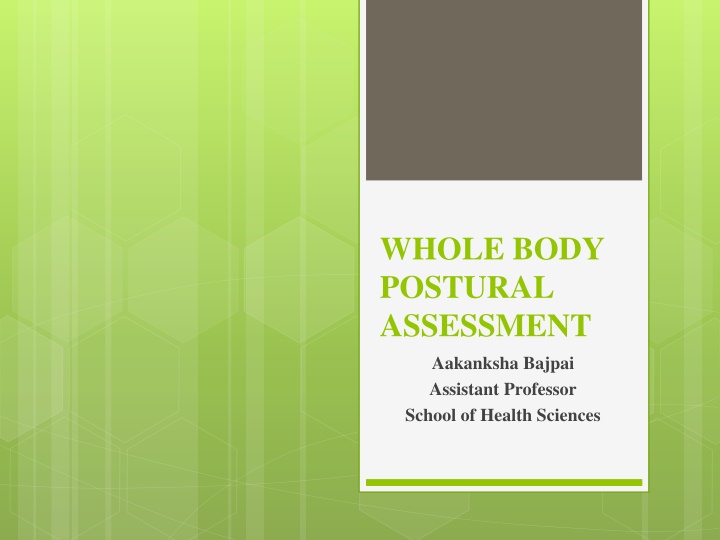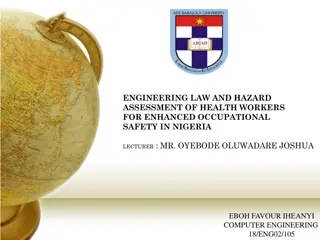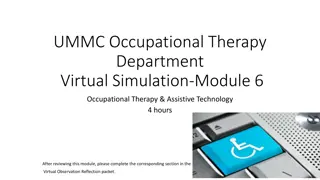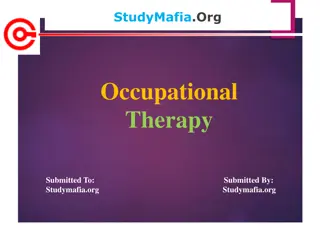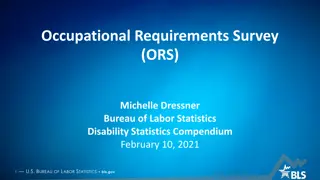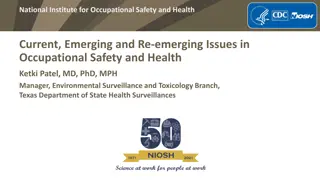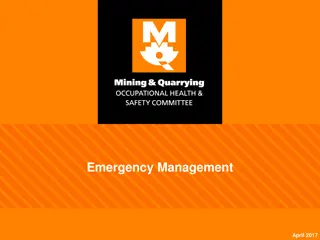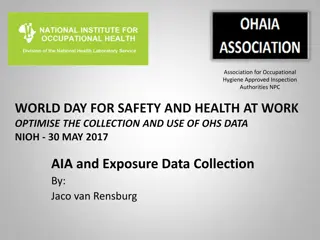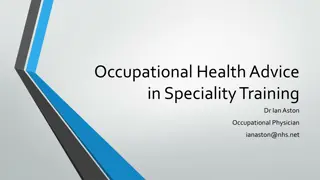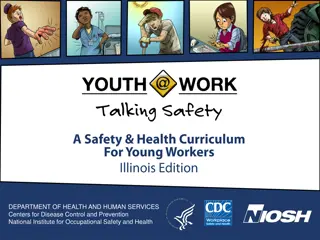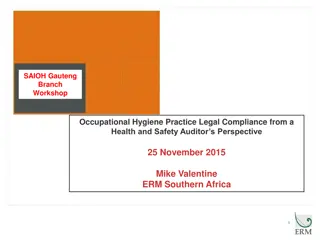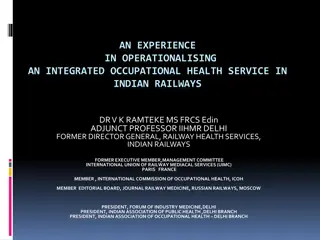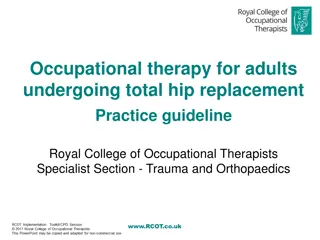The Importance of Whole Body Postural Assessment in Occupational Safety and Health
Whole body postural assessments play a crucial role in evaluating ergonomic factors in the workplace to prevent musculoskeletal disorders. Popular observational techniques such as NIOSH lifting equation, RULA, and REBA are commonly used. Ergonomic and job analysis checklists are tailored tools used by therapists for assessing work conditions. Checklists are essential tools for identifying problem areas and prioritizing improvement options. Manual Tasks Risk Assessment (ManTRA) is a valuable tool for auditing workplaces for musculoskeletal risk factors.
Download Presentation

Please find below an Image/Link to download the presentation.
The content on the website is provided AS IS for your information and personal use only. It may not be sold, licensed, or shared on other websites without obtaining consent from the author.If you encounter any issues during the download, it is possible that the publisher has removed the file from their server.
You are allowed to download the files provided on this website for personal or commercial use, subject to the condition that they are used lawfully. All files are the property of their respective owners.
The content on the website is provided AS IS for your information and personal use only. It may not be sold, licensed, or shared on other websites without obtaining consent from the author.
E N D
Presentation Transcript
WHOLE BODY POSTURAL ASSESSMENT Aakanksha Bajpai Assistant Professor School of Health Sciences
The most popular observational techniques included the National Institute for Occupational Safety and Health (NIOSH) lifting equation, psychophysical material handling data, body discomfort maps, and Rapid Upper Limb Assessment (RULA). More than 70% also used ergonomic checklists. Other observational techniques frequently referred to in the literature are whole body postural assessments Ovako Working Posture Analysis System (OWAS) and Rapid Entire Body Assessment (REBA) and upper limb posture and hand use assessments RULA and the Strain Index. A recently developed observational technique for whole body assessment also in use is Manual Tasks RiskAssessment (ManTRA).
There are almost as many ergonomic and job analysis checklists as there are therapists who conduct assessments of work. Each therapist has his or her preferred checklist or has developed one based on components from others. As with FCEs, the ergonomic and job analysis checklists most commonly used are custom-made (by self or company).
Two main types of checklists have been identified: Analysis and Action checklists. o Analysis checklists present a list of items that are analyzed and evaluated by the user. They are useful for inventory purposes to ensure that important aspects of a job or workplace are considered, to identify problem areas and compare different jobs or workplaces. o Action checklists present a list of actions that can be taken to improve the existing designs or conditions and are useful for prioritizing improvement options and training needs.
Checklists rely on the observation skills of the people using them and are often based on subjective assessment, which may lack precision. The role of checklists is as one of a range of practical evaluation tools for conducting social dialogue between employers, workers, users, and others concerned .
Manual Tasks Risk Assessment ManTRA was developed to assist health and safety inspectors audit workplaces for compliance with the Queensland Manual Tasks Advisory Standard and to make an assessment of exposure to musculoskeletal risk factors. When used in the workplace it is used by a team, including workers who perform the tasks assessed and staff responsible for manual task risk management. ManTRA has been used in a variety of workplaces such as mining, food production, construction, and health.
A task is assessed as a whole, rather than as task elements, and the assessment is based on a specific person s performance of the task, not people generally. The tool combines information about the total time for which a person performs the task in a typical day (exposure) and the typical time for which the task is performed without break (duration) . Four body regions (lower limbs, back, neck/shoulder, and arm/ wrist/hand) are all considered for five characteristics of the task (cycle time, force, speed, awkwardness, and vibration). Scores are calculated, and intervention may be indicated if certain critical values are exceeded.
Ovako Working Posture Analysing System The Ovako Working Posture Analysing System (OWAS) was developed as a practical method for identifying and evaluating poor working postures . It requires observation of work tasks every 30 or 60 seconds, and the postures of the back, upper limbs, and lower limbs are rated.80 The various posture combinations are classified into four action categories to determine whether intervention is required and how quickly the problem should be addressed. The length of time spent in various postures is also considered.
OWAS is considered easy to use and is focused on assessing posture, not risk of manual handling. Therefore, if you wish to determine the risk of manual handling operations, other tools should be used, such as ManTRA, the NIOSH lifting equation, or Manual Handling Assessment Charts.
The OWAS method was originally developed for use in the Finnish steel industry, but it has also been used in a wide range of other areas, including in the mining industry, with cleaners, with mechanics, with construction workers, with dairy farmers, with nurses,80 in the building industry, in the fishing industry, and in the seafood retail industry. OWAS has also been suggested for use in occupational rehabilitation. Inter-rater and test-retest (intra-rater) reliability of OWAS is considered good.
Rapid Entire Body Assessment REBA was developed as a postural analysis tool sensitive to the type of unpredictable working postures found in health care and other service industries. It has been used to assess jobs in health care and hospitals, supermarkets, and dental professions. REBA s approach and scoring system are based on RULA. Scoring is based on trunk, neck, and leg postures and load or force (Score A), upper and lower arms, wrist and coupling (Score B), and an activity rating. The score is then converted into a recommendation for action.
As with OWAS, REBA is focused on assessment of posture rather than manual handling risk. It is sensitive to detecting changes or improvements after ergonomic intervention; however, its focus is biomechanical, and workplace changes based on task repetition, length of shifts, and other factors that affect worker performance are not reflected in REBA scores. Initial studies indicate that REBA has acceptable inter-rater reliability; however, more detailed examination of reliability and validity is recommended by REBA s developers.
Rapid Upper Limb Assessment RULA was developed to investigate the exposure of individual workers to risk factors associated with work-related upper limb disorders . It is intended to be used as a screening tool and as part of a broader ergonomic survey covering epidemiologic, physical, mental, environmental and organizational factors. RULA assesses biomechanical and postural loading of the whole body, with particular focus on the neck, trunk, and upper limbs.
Deciding at what point of the work cycle to perform a RULA assessment is important. It can be based on the posture held for the longest time or the worst posture adopted or taken at regular intervals over the working period. Right and left upper limbs can be scored separately if necessary. RULA was originally developed using workers in the garment- making industry, with computer operators, and with workers performing a variety of manufacturing tasks. It has also been used with formwork carpenters, with truck drivers, in the retail seafood industry, in automotive assembly plants, and to assess the impact of different mouse positions when doing a computer task.
Construct validity of the RULA method has been established with significant associations between RULA scores and reported pain. Inter-rater reliability indicated high consistency of scoring .
Strain Index The Strain Index is a semi-quantitative job analysis method used to identify jobs that expose workers to increased risk of developing distal upper extremity (elbow, forearm, wrist, hand) disorders. The Strain Index produces a score representing the product of six task variables: intensity of exertion, duration of exertion, exertions per minute, hand and wrist posture, speed of work, and duration of task per day. It was originally developed for use in a pork processing plant and has also been used in turkey processing and automotive assembly.
The Strain Index has good test-retest and inter-rater reliability and has demonstrated predictive validity. When compared with RULA, however, results had very little correlation, indicating that results were not interchangeable and the instruments measured different constructs. It was recommended that if the job involved high hand intensity the Strain Index could be used, whereas if there were awkward upper limb postures adopted, then RULA could be used.
For areas with manual handling tasks, ManTRA will be used, whereas in areas that require a range of postures (static and dynamic) OWAS or REBA will be used. To address upper limb injury concerns, RULA will be used for tasks involving awkward upper limb postures, and the Strain Index will be used when tasks require high hand force and intensity.
